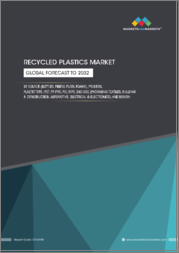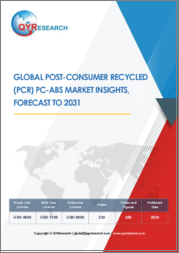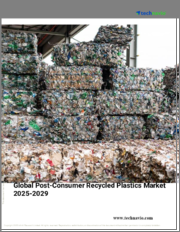
|
시장보고서
상품코드
1477040
세계의 재생 플라스틱 시장 규모 및 점유율 분석 : 동향, 촉진요인, 경쟁 구도, 예측(2024-2030년)Recycled Plastic Market Size & Share Analysis - Trends, Drivers, Competitive Landscape, and Forecasts (2024 - 2030) |
||||||
세계의 재생 플라스틱 시장 규모는 2023년에 682억 달러로, 2030년에는 1,227억 달러에 달하며, 8.5% 이상의 CAGR로 성장할 것으로 생각됩니다.
플라스틱 폐기물의 양을 줄이는 것에 대한 관심이 높아진 것이 시장 성장의 주요 요인입니다. 전 세계에서 상업화 및 산업화가 진행되면서 플라스틱 사용량이 증가하여 폐기물이 대량으로 발생하고 있습니다. 이러한 폐기물의 대량 생산과 적절한 처리 방법의 부재로 인해 높은 수준의 해양 및 육상 오염이 발생하고 있습니다. 국제자연보호연맹의 추산에 따르면 연간 약 1,400만 톤의 플라스틱이 바다로 흘러들어가고 있습니다. 제조업체, 각국 정부, 소비자 등 많은 이해관계자들은 플라스틱 소비 패턴을 점차 바꾸고, 폐폴리머를 재활용하고, 플라스틱 폐기물의 양을 줄이기 위해 기존 생산라인을 수정하고, 사용 후 쉽게 가공할 수 있는 제품을 개발하고 있습니다.
고급 플라스틱 재활용(화학적 재활용)은 소비자들이 사용한 플라스틱을 원래의 컴포넌트, 특수 폴리머, 새로운 플라스틱의 원료, 왁스, 연료 및 기타 다양한 유익한 제품으로 되돌릴 수 있는 다양한 절차로 구성됩니다. 이러한 혁신적인 기술은 더 많은 플라스틱을 환경으로부터 제거하고 더 많은 플라스틱을 유익하게 사용할 수 있도록 돕기 위해 폐플라스틱 산업을 크게 견인하고 있습니다.
주요 인사이트
아시아태평양은 업계에서 가장 큰 기여를 한 지역입니다. 이는 주로 이 지역에서 상당한 수의 소규모 처리 시설이 개발되었기 때문입니다.
북미는 향후 수년간 8.5%의 연평균 복합 성장률(CAGR)을 나타낼 것으로 예상됩니다. 이는 플라스틱 재활용량을 늘리기 위한 국내 역량 향상과 효율적이고 혁신적인 절차를 도입하여 플라스틱 재활용 공급망이 발전하고 있기 때문입니다.
포장재 카테고리는 향후 수년간 9.3% 이상의 CAGR을 나타낼 것으로 예상됩니다. 이는 파우치, 병, 필름, 랩의 재활용이 비교적 용이하고, 포장 폐기물을 재활용하기 위한 기계적인 방법을 쉽게 채택할 수 있으며, 재가공 제품에 대한 수요가 높기 때문입니다.
2023년 가장 많이 재활용된 소재는 PE로, 버진 소재의 대체품으로 다운스트림 부문에서 사용되는 재가공 소재를 생산하고 있습니다. 이 카테고리는 향후 수년간 9.4%의 연평균 복합 성장률(CAGR)로 더욱 발전할 것으로 보입니다. 그 주요 이유는 버진 PE의 생산량이 많고, 재활용률이 높으며, 폐기물 처리 및 발생량이 높기 때문입니다.
2023년에는 식품 및 음료 부문이 약 45%의 점유율을 차지하며 업계에 대한 기여가 가장 큽니다.
세계의 재생 플라스틱 시장을 분석했으며, 시장의 기본 구조·최신 상황 및 주요 촉진·억제요인, 세계 전체 및 지역별·주요 국가 시장 규모의 동향 전망(수량·금액 기반, 2017-2030년), 원료별·종류별·업종별 상세 동향, 현재의 시장 경쟁 상황, 주요 기업의 개요 등을 조사하여 전해드립니다.
목차
제1장 조사 범위
제2장 조사 방법
제3장 주요 요약
제4장 시장 지표
제5장 업계 전망
- 시장 역학
- 동향
- 촉진요인
- 억제요인/과제
- 촉진요인/억제요인의 영향 분석
- 신종 코로나바이러스 감염증(COVID-19)의 영향
- Porter's Five Forces 분석
제6장 세계 시장
- 개요
- 시장 규모 : 원료별(2017-2030년)
- 시장 매출 : 원료별(2017-2030년)
- 시장 규모 : 종류별(2017-2030년)
- 시장 매출 : 종류별(2017-2030년)
- 시장 규모 : 업종별(2017-2030년)
- 시장 매출 : 업종별(2017-2030년)
- 시장 규모 : 지역별(2017-2030년)
- 시장 매출 : 지역별(2017-2030년)
제7장 북미 시장
- 개요
- 시장 규모 : 원료별(2017-2030년)
- 시장 매출 : 원료별(2017-2030년)
- 시장 규모 : 종류별(2017-2030년)
- 시장 매출 : 종류별(2017-2030년)
- 시장 규모 : 업종별(2017-2030년)
- 시장 매출 : 업종별(2017-2030년)
- 시장 규모 : 국가별(2017-2030년)
- 시장 매출 : 국가별(2017-2030년)
제8장 유럽 시장
제9장 아시아태평양 시장
제10장 라틴아메리카 시장
제11장 중동 및 아프리카 시장
제12장 미국 시장
- 개요
- 시장 규모 : 원료별(2017-2030년)
- 시장 매출 : 원료별(2017-2030년)
- 시장 규모 : 종류별(2017-2030년)
- 시장 매출 : 종류별(2017-2030년)
- 시장 규모 : 업종별(2017-2030년)
- 시장 매출 : 업종별(2017-2030년)
제13장 캐나다 시장
제14장 독일 시장
제15장 프랑스 시장
제16장 영국 시장
제17장 이탈리아 시장
제18장 스페인 시장
제19장 일본 시장
제20장 중국 시장
제21장 인도 시장
제22장 호주 시장
제23장 한국 시장
제24장 브라질 시장
제25장 멕시코 시장
제26장 사우디아라비아 시장
제27장 남아프리카공화국 시장
제28장 아랍에미리트(UAE) 시장
제29장 경쟁 구도
- 시장 참여 기업과 제공 품목 리스트
- 주요 기업의 경쟁 벤치마킹
- 주요 기업의 제품 벤치마킹
- 최근 전략적 도입
제30장 기업 개요
- Veolia Environnement SA
- MBA Polymers Inc.
- Phoenix Technologies International LLC
- Vikoz Enterprises Inc.
- TERRACYCLE INC.
- KW Plastics
- DS Smith plc
- Petco.co.za
- Waste Connections Inc.
- Custom Polymers Inc.
- Indorama Ventures Public Company Limited
제31장 부록
KSA 24.05.22The recycled plastic market was USD 68.2 billion in 2023, and it will touch USD 122.7 billion, with more than 8.5% CAGR, by 2030.
The rising emphasis on reducing plastic waste volume is a major driver. The worldwide increase in commercialization and industrialization has boosted the usage of plastics, which has resulted in high waste production.
This high-volume production of waste and lack of appropriate disposal channels have added to the generation of high levels of marine and land pollution.
As per the International Union for Conservation of Nature estimates, approximately 14 million tons of plastics culminate in oceans annually.
Many stakeholders, such as manufacturers, governments, and consumers, are progressively shifting plastic consumption patterns, recycling waste polymers, fixing conventional production lines to decrease the volume of plastic waste, and developing goods that are simply processable post-use.
Biocontamination and waste are major problems, which have led local municipalities to establish parallel economies to control waste volumes.
Advanced plastics recycling, or chemical recycling, comprises various procedures for transforming post-consumer polymers back into their original building blocks, specialty polymers, feedstocks for new plastics, waxes, fuels, and various other beneficial products.
Such innovative technologies are considerably driving the industry for used plastics to assist in keeping more plastics out of the environment and in beneficial use.
Key Insights
APAC was the largest contributor to the industry. This is primarily because of the development of a substantial number of small-scale processing facilities in this region.
North America is likely to advance at an 8.5% compound annual growth rate in the years to come.
This will be credited to the improvement of domestic abilities to enhance plastic recycling quantities and the advancements in the plastics recycling supply chain through the incorporation of efficient and innovative procedures.
The packaging materials category is likely to advance at more than 9.3% compound annual growth rate in the years to come.
This is because of the relative ease with which pouches, bottles, films, and wraps can be recycled, the easy employment of mechanical methods for recycling packaging waste, and the high need for reprocessed products.
PE was the most recycled material in 2023, generating reprocessed material for implementation in downstream sectors as a replacement for virgin material. This category will further advance at a 9.4% CAGR in the years to come.
This is mainly because of the high manufacturing volume of virgin PE, a significant recycling rate for it, and a high waste disposal and generation level.
The food & beverage category was the largest contributor to the industry in 2023, with a share of approximately 45%.
The food & beverage sector utilizes various plastics, including HDPE, PET, PP, PS, and LDPE, for storage, packaging, preservation, ease of transportation, and improving the visual appeal of processed food & beverages, specifically perishable items.
The recycled plastic industry is very fragmented and categorized by the existence of extremely concentrated low-capacity companies across different regions.
These local vendors and regional companies have a low-volume plastic processing capability and have collection systems or purchase waste from industrial and residential waste producers.
Table of Contents
Chapter 1. Research Scope
- 1.1. Research Objectives
- 1.2. Market Definition
- 1.3. Analysis Period
- 1.4. Market Size Breakdown by Segments
- 1.4.1. Market size breakdown, by source
- 1.4.2. Market size breakdown, by type
- 1.4.3. Market size breakdown, by industry
- 1.4.4. Market size breakdown, by region
- 1.4.5. Market size breakdown, by country
- 1.5. Market Data Reporting Unit
- 1.5.1. Volume
- 1.5.2. Value
- 1.6. Key Stakeholders
Chapter 2. Research Methodology
- 2.1. Secondary Research
- 2.1.1. Paid
- 2.1.2. Unpaid
- 2.1.3. P&S Intelligence database
- 2.2. Primary Research
- 2.3. Market Size Estimation
- 2.4. Data Triangulation
- 2.5. Currency Conversion Rates
- 2.6. Assumptions for the Study
- 2.7. Notes and Caveats
Chapter 3. Executive Summary
Chapter 4. Market Indicators
Chapter 5. Industry Outlook
- 5.1. Market Dynamics
- 5.1.1. Trends
- 5.1.2. Drivers
- 5.1.3. Restraints/challenges
- 5.1.4. Impact analysis of drivers/restraints
- 5.2. Impact of COVID-19
- 5.3. Porter's Five Forces Analysis
- 5.3.1. Bargaining power of buyers
- 5.3.2. Bargaining power of suppliers
- 5.3.3. Threat of new entrants
- 5.3.4. Intensity of rivalry
- 5.3.5. Threat of substitutes
Chapter 6. Global Market
- 6.1. Overview
- 6.2. Market Volume, by Source (2017-2030)
- 6.3. Market Revenue, by Source (2017-2030)
- 6.4. Market Volume, by Type (2017-2030)
- 6.5. Market Revenue, by Type (2017-2030)
- 6.6. Market Volume, by Industry (2017-2030)
- 6.7. Market Revenue, by Industry (2017-2030)
- 6.8. Market Volume, by Region (2017-2030)
- 6.9. Market Revenue, by Region (2017-2030)
Chapter 7. North America Market
- 7.1. Overview
- 7.2. Market Volume, by Source (2017-2030)
- 7.3. Market Revenue, by Source (2017-2030)
- 7.4. Market Volume, by Type (2017-2030)
- 7.5. Market Revenue, by Type (2017-2030)
- 7.6. Market Volume, by Industry (2017-2030)
- 7.7. Market Revenue, by Industry (2017-2030)
- 7.8. Market Volume, by Country (2017-2030)
- 7.9. Market Revenue, by Country (2017-2030)
Chapter 8. Europe Market
- 8.1. Overview
- 8.2. Market Volume, by Source (2017-2030)
- 8.3. Market Revenue, by Source (2017-2030)
- 8.4. Market Volume, by Type (2017-2030)
- 8.5. Market Revenue, by Type (2017-2030)
- 8.6. Market Volume, by Industry (2017-2030)
- 8.7. Market Revenue, by Industry (2017-2030)
- 8.8. Market Volume, by Country (2017-2030)
- 8.9. Market Revenue, by Country (2017-2030)
Chapter 9. APAC Market
- 9.1. Overview
- 9.2. Market Volume, by Source (2017-2030)
- 9.3. Market Revenue, by Source (2017-2030)
- 9.4. Market Volume, by Type (2017-2030)
- 9.5. Market Revenue, by Type (2017-2030)
- 9.6. Market Volume, by Industry (2017-2030)
- 9.7. Market Revenue, by Industry (2017-2030)
- 9.8. Market Volume, by Country (2017-2030)
- 9.9. Market Revenue, by Country (2017-2030)
Chapter 10. LATAM Market
- 10.1. Overview
- 10.2. Market Volume, by Source (2017-2030)
- 10.3. Market Revenue, by Source (2017-2030)
- 10.4. Market Volume, by Type (2017-2030)
- 10.5. Market Revenue, by Type (2017-2030)
- 10.6. Market Volume, by Industry (2017-2030)
- 10.7. Market Revenue, by Industry (2017-2030)
- 10.8. Market Volume, by Country (2017-2030)
- 10.9. Market Revenue, by Country (2017-2030)
Chapter 11. MEA Market
- 11.1. Overview
- 11.2. Market Volume, by Source (2017-2030)
- 11.3. Market Revenue, by Source (2017-2030)
- 11.4. Market Volume, by Type (2017-2030)
- 11.5. Market Revenue, by Type (2017-2030)
- 11.6. Market Volume, by Industry (2017-2030)
- 11.7. Market Revenue, by Industry (2017-2030)
- 11.8. Market Volume, by Country (2017-2030)
- 11.9. Market Revenue, by Country (2017-2030)
Chapter 12. U.S. Market
- 12.1. Overview
- 12.2. Market Volume, by Source (2017-2030)
- 12.3. Market Revenue, by Source (2017-2030)
- 12.4. Market Volume, by Type (2017-2030)
- 12.5. Market Revenue, by Type (2017-2030)
- 12.6. Market Volume, by Industry (2017-2030)
- 12.7. Market Revenue, by Industry (2017-2030)
Chapter 13. Canada Market
- 13.1. Overview
- 13.2. Market Volume, by Source (2017-2030)
- 13.3. Market Revenue, by Source (2017-2030)
- 13.4. Market Volume, by Type (2017-2030)
- 13.5. Market Revenue, by Type (2017-2030)
- 13.6. Market Volume, by Industry (2017-2030)
- 13.7. Market Revenue, by Industry (2017-2030)
Chapter 14. Germany Market
- 14.1. Overview
- 14.2. Market Volume, by Source (2017-2030)
- 14.3. Market Revenue, by Source (2017-2030)
- 14.4. Market Volume, by Type (2017-2030)
- 14.5. Market Revenue, by Type (2017-2030)
- 14.6. Market Volume, by Industry (2017-2030)
- 14.7. Market Revenue, by Industry (2017-2030)
Chapter 15. France Market
- 15.1. Overview
- 15.2. Market Volume, by Source (2017-2030)
- 15.3. Market Revenue, by Source (2017-2030)
- 15.4. Market Volume, by Type (2017-2030)
- 15.5. Market Revenue, by Type (2017-2030)
- 15.6. Market Volume, by Industry (2017-2030)
- 15.7. Market Revenue, by Industry (2017-2030)
Chapter 16. U.K. Market
- 16.1. Overview
- 16.2. Market Volume, by Source (2017-2030)
- 16.3. Market Revenue, by Source (2017-2030)
- 16.4. Market Volume, by Type (2017-2030)
- 16.5. Market Revenue, by Type (2017-2030)
- 16.6. Market Volume, by Industry (2017-2030)
- 16.7. Market Revenue, by Industry (2017-2030)
Chapter 17. Italy Market
- 17.1. Overview
- 17.2. Market Volume, by Source (2017-2030)
- 17.3. Market Revenue, by Source (2017-2030)
- 17.4. Market Volume, by Type (2017-2030)
- 17.5. Market Revenue, by Type (2017-2030)
- 17.6. Market Volume, by Industry (2017-2030)
- 17.7. Market Revenue, by Industry (2017-2030)
Chapter 18. Spain Market
- 18.1. Overview
- 18.2. Market Volume, by Source (2017-2030)
- 18.3. Market Revenue, by Source (2017-2030)
- 18.4. Market Volume, by Type (2017-2030)
- 18.5. Market Revenue, by Type (2017-2030)
- 18.6. Market Volume, by Industry (2017-2030)
- 18.7. Market Revenue, by Industry (2017-2030)
Chapter 19. Japan Market
- 19.1. Overview
- 19.2. Market Volume, by Source (2017-2030)
- 19.3. Market Revenue, by Source (2017-2030)
- 19.4. Market Volume, by Type (2017-2030)
- 19.5. Market Revenue, by Type (2017-2030)
- 19.6. Market Volume, by Industry (2017-2030)
- 19.7. Market Revenue, by Industry (2017-2030)
Chapter 20. China Market
- 20.1. Overview
- 20.2. Market Volume, by Source (2017-2030)
- 20.3. Market Revenue, by Source (2017-2030)
- 20.4. Market Volume, by Type (2017-2030)
- 20.5. Market Revenue, by Type (2017-2030)
- 20.6. Market Volume, by Industry (2017-2030)
- 20.7. Market Revenue, by Industry (2017-2030)
Chapter 21. India Market
- 21.1. Overview
- 21.2. Market Volume, by Source (2017-2030)
- 21.3. Market Revenue, by Source (2017-2030)
- 21.4. Market Volume, by Type (2017-2030)
- 21.5. Market Revenue, by Type (2017-2030)
- 21.6. Market Volume, by Industry (2017-2030)
- 21.7. Market Revenue, by Industry (2017-2030)
Chapter 22. Australia Market
- 22.1. Overview
- 22.2. Market Volume, by Source (2017-2030)
- 22.3. Market Revenue, by Source (2017-2030)
- 22.4. Market Volume, by Type (2017-2030)
- 22.5. Market Revenue, by Type (2017-2030)
- 22.6. Market Volume, by Industry (2017-2030)
- 22.7. Market Revenue, by Industry (2017-2030)
Chapter 23. South Korea Market
- 23.1. Overview
- 23.2. Market Volume, by Source (2017-2030)
- 23.3. Market Revenue, by Source (2017-2030)
- 23.4. Market Volume, by Type (2017-2030)
- 23.5. Market Revenue, by Type (2017-2030)
- 23.6. Market Volume, by Industry (2017-2030)
- 23.7. Market Revenue, by Industry (2017-2030)
Chapter 24. Brazil Market
- 24.1. Overview
- 24.2. Market Volume, by Source (2017-2030)
- 24.3. Market Revenue, by Source (2017-2030)
- 24.4. Market Volume, by Type (2017-2030)
- 24.5. Market Revenue, by Type (2017-2030)
- 24.6. Market Volume, by Industry (2017-2030)
- 24.7. Market Revenue, by Industry (2017-2030)
Chapter 25. Mexico Market
- 25.1. Overview
- 25.2. Market Volume, by Source (2017-2030)
- 25.3. Market Revenue, by Source (2017-2030)
- 25.4. Market Volume, by Type (2017-2030)
- 25.5. Market Revenue, by Type (2017-2030)
- 25.6. Market Volume, by Industry (2017-2030)
- 25.7. Market Revenue, by Industry (2017-2030)
Chapter 26. Saudi Arabia Market
- 26.1. Overview
- 26.2. Market Volume, by Source (2017-2030)
- 26.3. Market Revenue, by Source (2017-2030)
- 26.4. Market Volume, by Type (2017-2030)
- 26.5. Market Revenue, by Type (2017-2030)
- 26.6. Market Volume, by Industry (2017-2030)
- 26.7. Market Revenue, by Industry (2017-2030)
Chapter 27. South Africa Market
- 27.1. Overview
- 27.2. Market Volume, by Source (2017-2030)
- 27.3. Market Revenue, by Source (2017-2030)
- 27.4. Market Volume, by Type (2017-2030)
- 27.5. Market Revenue, by Type (2017-2030)
- 27.6. Market Volume, by Industry (2017-2030)
- 27.7. Market Revenue, by Industry (2017-2030)
Chapter 28. U.A.E. Market
- 28.1. Overview
- 28.2. Market Volume, by Source (2017-2030)
- 28.3. Market Revenue, by Source (2017-2030)
- 28.4. Market Volume, by Type (2017-2030)
- 28.5. Market Revenue, by Type (2017-2030)
- 28.6. Market Volume, by Industry (2017-2030)
- 28.7. Market Revenue, by Industry (2017-2030)
Chapter 29. Competitive Landscape
- 29.1. List of Market Players and their Offerings
- 29.2. Competitive Benchmarking of Key Players
- 29.3. Product Benchmarking of Key Players
- 29.4. Recent Strategic Developments
Chapter 30. Company Profiles
- 30.1. Veolia Environnement SA
- 30.1.1. Business overview
- 30.1.2. Product and service offerings
- 30.1.3. Key financial summary
- 30.2. MBA Polymers Inc.
- 30.2.1. Business overview
- 30.2.2. Product and service offerings
- 30.2.3. Key financial summary
- 30.3. Phoenix Technologies International LLC
- 30.3.1. Business overview
- 30.3.2. Product and service offerings
- 30.3.3. Key financial summary
- 30.4. Vikoz Enterprises Inc.
- 30.4.1. Business overview
- 30.4.2. Product and service offerings
- 30.4.3. Key financial summary
- 30.5. TERRACYCLE INC.
- 30.5.1. Business overview
- 30.5.2. Product and service offerings
- 30.5.3. Key financial summary
- 30.6. KW Plastics
- 30.6.1. Business overview
- 30.6.2. Product and service offerings
- 30.6.3. Key financial summary
- 30.7. DS Smith plc
- 30.7.1. Business overview
- 30.7.2. Product and service offerings
- 30.7.3. Key financial summary
- 30.8. Petco.co.za
- 30.8.1. Business overview
- 30.8.2. Product and service offerings
- 30.8.3. Key financial summary
- 30.9. Waste Connections Inc.
- 30.9.1. Business overview
- 30.9.2. Product and service offerings
- 30.9.3. Key financial summary
- 30.10. Custom Polymers Inc.
- 30.10.1. Business overview
- 30.10.2. Product and service offerings
- 30.10.3. Key financial summary
- 30.11. Indorama Ventures Public Company Limited
- 30.11.1. Business overview
- 30.11.2. Product and service offerings
- 30.11.3. Key financial summary
Chapter 31. Appendix
- 31.1. Abbreviations
- 31.2. Sources and References
- 31.3. Related Reports



















